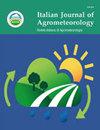Estimation of measured evapotranspiration using data-driven methods with limited meteorological variables
IF 0.8
4区 农林科学
Q2 AGRONOMY
Italian Journal of Agrometeorology-Rivista Italiana Di Agrometeorologia
Pub Date : 2021-01-01
DOI:10.36253/ijam-1055
引用次数: 9
Abstract
Determination of surface energy balance depends on the energy exchange between land and atmosphere. Thus, crop, soil and meteorological factors are crucial, particularly in agricultural fields. Evapotranspiration is derived from latent heat component of surface energy balance and is a key factor to clarify the energy transfer mechanism. Development of the methods and technologies for the aim of determining and measuring of evapotranspiration have been one of the main focus points for researchers. However, the direct measurement systems are not common because of economic reasons. This situation causes that different methods are used to estimate evapotranspiration, particularly in locations where no measurements are made. Thus, in this study, non-linear techniques were applied to make accurate estimations of evapotranspiration over the winter wheat canopy located in the field of Atatürk Soil Water and Agricultural Meteorology Research Institute Directorate, Kırklareli, Turkey. This is the first attempt in the literature which consist of the comparison of different machine learning methods in the evapotranspiration values obtained by the Bowen Ratio Energy Balance system. In order to accomplish this aim, support-vector machine, Adaptive neuro fuzzy inference system and Artificial neural network models have been evaluated for different input combinations. The results revealed that even with only global solar radiation data taken as an input, a high prediction accuracy can be achieved. These results are particularly advantageous in cases where the measurement of meteorological variables is limited. With the results of this study, progress can be made in the efficient use and management of water resources based on the input parameters of evapotranspiration especially for regions with limited data.利用有限气象变量的数据驱动方法估算实测蒸散量
地表能量平衡的确定取决于陆地和大气之间的能量交换。因此,作物、土壤和气象因素至关重要,特别是在农业领域。蒸散发来源于地表能量平衡的潜热分量,是阐明能量传递机制的关键因素。测定和测量植物蒸散量的方法和技术的发展一直是研究人员关注的焦点之一。然而,由于经济原因,直接测量系统并不常见。这种情况导致使用不同的方法来估计蒸散发,特别是在没有进行测量的地方。因此,在本研究中,应用非线性技术对土耳其atatat rk土壤水与农业气象研究所理事会(Kırklareli)大田的冬小麦冠层蒸散量进行了精确估算。这是文献中第一次尝试比较不同机器学习方法在鲍文比能量平衡系统得到的蒸散发值。为了实现这一目标,对不同的输入组合进行了支持向量机、自适应神经模糊推理系统和人工神经网络模型的评价。结果表明,即使仅以全球太阳辐射数据作为输入,也可以获得较高的预测精度。这些结果在气象变量测量有限的情况下特别有利。研究结果可为基于蒸散发输入参数的水资源高效利用与管理提供参考,特别是在数据有限的地区。
本文章由计算机程序翻译,如有差异,请以英文原文为准。
求助全文
约1分钟内获得全文
求助全文
来源期刊

Italian Journal of Agrometeorology-Rivista Italiana Di Agrometeorologia
AGRONOMY-ENVIRONMENTAL SCIENCES
CiteScore
2.10
自引率
8.30%
发文量
6
期刊介绍:
Among the areas of specific interest of the journal there are: ecophysiology; phenology; plant growth, quality and quantity of production; plant pathology; entomology; welfare conditions of livestocks; soil physics and hydrology; micrometeorology; modeling, simulation and forecasting; remote sensing; territorial planning; geographical information systems and spatialization techniques; instrumentation to measure physical and biological quantities; data validation techniques, agroclimatology; agriculture scientific dissemination; support services for farmers.
 求助内容:
求助内容: 应助结果提醒方式:
应助结果提醒方式:


